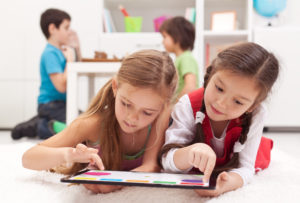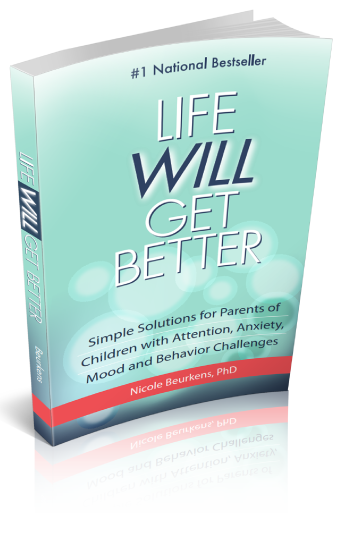What is a break break?
When children have a lot of schoolwork to do, whether at home or in school, one of the most important things that can get neglected is movement. Movement breaks not only help kids release some of the energy that builds up when sitting, it also allows them to sharpen their brain’s ability to focus. While movement breaks tend to be more common with younger kids (if they are used at all), by the time kids hit middle school very few opportunities are provided for movement throughout the day. Movement breaks are very important for children of all ages, and even adults!
Right now many parents and children are spending their days at home for work and school. Movement-focused brain breaks are a great way to help everyone feel better and get their tasks done each day.
Research has demonstrated the many benefits of movement and exercise for preventing and treating a wide range of physical and mental health conditions. Physical activity helps to improve mood and focus, which is why it’s so important to include in your daily routine. In addition, muscle movement develops the connections between different regions of the brain and nervous system which keeps the brain active and flexible. Movement is especially important for children, since it allows them to develop in many areas. Their motor skills, social skills, attention habits, and more are all greatly influenced by the amount of movement they get each day.
Taking a break from whatever you’re working on for just a few minutes helps your brain refocus to the task at hand, allows you to better absorb new information, and reduces the physical effects of sitting for long periods of time. When we feel like we have too much work, we often forget to take care of ourselves. This can prove detrimental in the long run, because a healthy body means a healthy brain! Providing ourselves and our children with short “brain breaks” is one of the best ways to encourage happier, healthier learning habits. Plus, it can be a lot of fun!
So what are some brain break activities for kids?
I’ve compiled 25 of my favorite activities for kids to either do on their own or together with a parent to give their brains a break from the monotony of jobs, studying, and homework.
- Squiggle Drawing: This one is great for kids and adults. Start out by drawing a random squiggle on a piece of paper. Then, turn that squiggle into a work of art! Be creative and see what pictures you can come up with. This can also be a fun cooperative game where you and your child each take turns adding a single line to the picture to create something together.
- Exercise Break: One easy way to quickly get the blood flowing into your brain is to do some simple exercises for a couple of minutes. Jumping jacks, wall push-ups, and running in place are easy ones to start with.
- Dance Party: Who doesn’t love music? Turn on a favorite song and have a mini dance party. The more you move, the better. Plus you can show off some of your epic old-school dance moves to entertain the kids!
- Weight Lifting: For this break you don’t have to do anything flashy. Take a couple minutes to lift light weights with each arm. Not only will this help your brain, it will also help you become stronger.
- Popcorn Jumps: Smaller kids will have a blast with this one, but be sure to give them enough room. Popcorn jumping is just jumping but where you start and end in a squatting position. It’s great for releasing a lot of energy in a short period of time! You can even say “pop” out loud with each jump.
- Bounce on a Ball: Bouncing around the house on an exercise ball or toy is a great way to have some fun and get out a lot of energy. Two kids could try racing each other, or complete a certain “track” around some obstacles.
- Letter Guess: My kids have used this simple game since they were very young to pass the time and have some fun. One player uses their finger to “draw” a letter on the back of the other player, who then guesses which letter it was. Try mixing in upper- and lowercase letters to make it more challenging!
- Yoga Poses: Try out some yoga poses. Start simple and increase the challenge as you go. The best part is that you don’t need any equipment and anyone can learn! Here are some links to get you started if you don’t already know some basic poses: https://www.kidsyogastories.com/kids-yoga-poses/ and https://www.purewow.com/family/yoga-poses-for-kids
- Trampoline Bounce: Kids will love to take a break from their work to bounce on a trampoline. If you don’t own one, bouncing on the bed works great too.
- March Around the House: High-stepping or marching around the house is an easy and fun way to mix up the normal routine. Mix in some skipping or jogging for extra fun.
- Rock, Paper, Scissors, Math: Here’s a fun counting game for two players. Each person calls out “rock, paper, scissors…math!” and hold out a number of fingers instead of the normal symbols. The first player to say the correct sum of both players’ numbers wins! Try mixing in other operations for older kids or to make the activity different each time.
- Bean Bag Toss: Kids can do this one on their own, or compete against each other. You don’t even need bean bags – use anything that can be safely tossed. Just take turns trying to toss bean bags or balls into a box. Or, make up a scoring system and play a longer game.
- Tongue Twisters: Have your child try saying some classic tongue twisters like “She sells seashells by the sea shore.” How fast can they say it? Can you say it faster? Can they move their body while saying it?
- Draw a Picture: Fill a jar with ideas for different things to draw, like family members, pets, or places. When it’s time for a brain break your child can randomly pick one and draw it. For more challenge and fun, they can pick multiple cards and combine them into one masterpiece.
- Biking Adventure: Biking is a great activity because it’s just as fun alone or with the whole family. Kids can ride in the driveway by themselves, or you can take a trip through the neighborhood. My family likes to drive to nearby trails if we have the extra time to spare.
- Work Standing Up: This one is very straightforward. Use boxes or books to raise whatever you’re working on high enough so that you can stand for a bit while you work.
- Keep it Up: Kids of all ages can have some fun with this one! The object is to keep a balloon from hitting the ground without holding onto it. Multiple people can play at once, or you can use a volleyball or beach ball to increase the challenge.
- Breathing Awareness: One easy trick to refocus our brain is to focus on one aspect of our body. This draws the brain away from distracting thoughts. Try breathing in deeply while counting to 4, holding for another 4-count, exhaling, holding, and so on. Deep breathing is a very useful habit to develop, as it increases productivity and self-awareness.
- Stretch Break: Take a moment to stretch out. It’s never good to sit for a long period of time, so even just taking a minute to stretch your back, arms, and legs can be really helpful for keeping your body healthy. Sun salutations, neck rolls, and shoulder rolls are some of my personal favorites!
- Just Sit Still: Challenge yourself to spend two minutes just sitting (or lying) still, with your eyes closed. It’s amazing how easily this can reset your brain! For littler kids, try it for one minute first.
- Grab a Drink: Even doing something as simple as walking to the kitchen to grab a cold glass of water can be a great way to relax for a minute.
- Play a Musical Instrument: Playing an instrument is a great activity for adults and children alike. Whether it’s just having fun with a miniature drum set or practicing a new piano piece, making music is an enjoyable and rewarding way to get a break from work.
- Hopscotch: Kids can head outside and use chalk to draw a hopscotch court on the driveway, then play a game by themselves or together with friends and family.
- Build an Obstacle Course: Using objects from around the house, set up a mini obstacle course. This is a great way for little kids to burn off some energy, or for older kids to give themselves a challenge!
- Go on a Scavenger Hunt: Give your child an object to find in the house or outside, such as a certain picture or book. For a longer activity, you can hide a series of clues that lead to a prize at the end.
Why do students need brain breaks?
Break breaks can be an especially important part of any student’s daily routine. Between large amounts of homework and studying, on top of hours of sitting in class every day, getting out of the chair for just a few minutes every hour is super important for keeping their energy up, giving the brain a reprieve from focused work, and helping them reset for more effective studying!
Do brain breaks work?
The short answer is yes! Brain breaks absolutely work wonders, and my family is full of staunch supporters for them. While we all have our preferred ways to take a quick break from school or work, we all value the effectiveness and necessity of taking frequent breaks. Especially in today’s largely digital world, it’s more important than ever to give them a try and see what works for you.
It can be easy and fun to get plenty of movement on even the busiest days, while keeping everyone more productive. With these activities and your own creativity, you’ll never be without a way to refocus while you work or study!
What You Should Do Next:
Sign up for my Better Behavior Naturally community newsletter
Sign up for my newsletter to get tips, resources, and supports to improve your child’s attention, anxiety, mood, and behavior…while making your job as a parent easier.
Enroll in one of my workshops
Check out one of my many workshops where you’ll join my exclusive community of parents in a one-of-a-kind virtual resource accessible 24/7. Whether you’ve got a child with a diagnosis like autism or ADHD, or are becoming more and more frustrated with a child who struggles to listen and cope, these workshops are designed to give you the information, tools, and support you need…whenever you need it.








